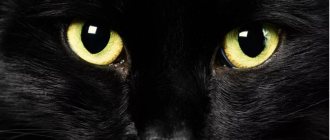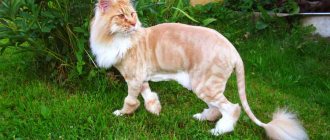Psychological readiness
To participate in an exhibition, an animal must be mentally prepared; those with a docile, peaceful character perform especially well - aggression at exhibitions is unacceptable and leads to disqualification. The cat must be adapted:
- to loud sounds;
- various smells;
- a large number of people;
- constant attention;
- in the wrong hands.
To do this, owners of more than one generation of cats always take 3-4 month old kittens with them to exhibitions. Yes, these kids are not participating, but they are already getting used to the exhibition rhythm.
What to do if the cat has not been trained since childhood? Then, 3-6 months before the exhibition, regular psychological training begins, including:
- going outside in a carrier;
- travel by car;
- stay in an exhibition and portable cage;
- gatherings with strangers.
To train, people unfamiliar to the cat (but not the owner!) should calmly pick up the animal, carefully examine it, and then return it to the cage. You can take your cat to visit your family and friends. It’s good if the cat has the opportunity to play and communicate with cats or dogs - in this case, he is calmer about the presence of other animals.
Adaptation will be faster if the cat makes friends with the exhibition cage ahead of time. To do this, toys and bedding are placed in the cage, trying to interest the pet.
Some veterinarians and cattery owners advise giving the cat sedatives 2-3 days before the exhibition, but in this case the owner must be careful with the dosage so that the cat does not become lethargic and apathetic at the event.
How to touch a puppy?
Teaching your baby to be touched is not difficult. Stroke and touch the puppy; as a rule, cubs like to be “sniffed” in all sorts of ways. But often small puppies like to “bite” their owner’s palms in every possible way. Under no circumstances even think about teaching your baby such “games” if now they seem cute and funny to you. In the future, when bite marks from an adult dog are constantly present on your palms, this will no longer seem like fun entertainment to you.
However, in addition to regular touching, it is important to train your pet to show its teeth. To do this, say the command “teeth” and carefully, without ever causing pain to the dog, expose the upper and lower jaw with your hands.
Probably, at first the restless little kitten will not really like this, and he will try to escape from your hands in every possible way. During the process, calm the baby with your voice; after the “procedure”, be sure to praise him and treat him with a treat. The main thing in this matter is calmness and practice. Repeat this manipulation with your pet regularly several times a day, and you will certainly notice how the puppy will gradually begin to get used to it.
Physical Compliance
Any preparation for a cat show makes sense if the animal has no physical defects and meets breed standards. Each breed has its own beauty parameters.
Health
The health of your pet is of great importance; for this, on the eve of exhibition events, you should conduct a veterinary examination and obtain a certificate:
- form 1 - for an exhibition in another city;
- Form 4 - for an event in your city.
A cat that the owner intends to demonstrate at an exhibition must be treated for fleas and helminths, which is noted in the veterinary passport.
There must also be a record of vaccinations:
- against rabies;
- chlamydia;
- leukemia;
- panleukopenia;
- rhinotracheitis;
- calicivirus.
Preparing for a cat show includes taking medications to relieve sexual arousal.
Nutrition
To ensure that the animal looks healthy, but not fat, and has a shiny coat, special attention is paid to nutrition a month before the exhibition.
2-3 weeks before the exhibition, the pet can be switched to food with a high protein content or to special food for pregnant cats or kittens. You should first make sure that the new food will not cause allergies in the animal.
If the pet has gained excess weight, it is transferred to a fasting diet 5-6 weeks before the event.
Although premium food contains a vitamin supplement, to improve appearance 3-4 weeks before the exhibition you can additionally introduce the following into the diet:
- seaweed - in some cases it brightens the color and color of the eyes;
- biotin and B vitamins - stimulate hair growth;
- carrots enhance the red color.
Important! 3-4 weeks before the exhibition, the cat should be encouraged to exercise.
I tried many different methods and "grandfather's methods"
I found only one worthy of attention, which has been helping me out for a long time. Through trial and error, I realized that the problem of sexual heat and aggression in cats should be solved in advance, because it is almost impossible to urgently stop the estrus of a cat that has gone on a spree.
Most of my pets are involved in breeding, so neutering is not an option for them. Another way to solve the problem of sexual heat in cats is mating. But it also does not guarantee a quick cessation of estrus and is always planned in advance. It is not recommended to take a pregnant cat to an exhibition, because there is a high risk of contracting an infection. Stress can also cause a cat to lose her kittens. If the judge determines that your cat is pregnant, he may disqualify the pet.
Preparing the appearance
Grooming is an important element of preparing a cat for an exhibition; it emphasizes the thoroughbred and beauty of the animal.
Taking care of your pet’s appearance begins not a day or two before the event, but from the birth of the kitten. The cat is washed occasionally (or when it is very dirty), but depending on the length of the coat, it is combed 1-2 times a week. Regularly clean the animal's ears and eyes, trim its claws, and remove tartar.
Before the exhibition, all these procedures are mandatory in full; they must demonstrate the merits of the pet in the best possible way.
the washing up
Preparing for a cat show begins with bathing, but first you need to:
- comb with a sparse comb to rid the cover of dead hairs;
- trim claws;
- clean the inside of the ears;
- if the standard allows, pluck the hair on the ears from above;
- Place cotton balls in your ears.
When bathing, the cat should have support under its feet.
Washing takes place in 5 stages:
- Using products for deep cleaning of fur, thoroughly soap the animal. Particular attention is paid to the locations of the glands - behind the ears, under the tail, paws, pants. Light wool is bleached with special means, keeping them on the cover for 3-5 minutes. Rinse thoroughly, adding vinegar (4 tbsp per 10 liters) or citric acid (1 tsp per 1 liter).
- Another soaping with a degreasing shampoo is combined with combing. A wide-toothed metal comb will come in handy. Lather your hair with a sponge or toothbrush. Rinse the animal with plenty of water.
- Lathering with exhibition shampoo, special attention to the face and paws. Rinse.
- Lathering with tinted shampoo, which will add brightness and shine to the coat. Leave for 10-15 minutes and wash off.
- For volume, the wool is treated with conditioner and styling gel. Then you need to rinse the cat thoroughly
Breeder experience
I have been breeding Scottish cats for almost 10 years. In my Hollycat cattery we work with rare colors of Scottish cats. We strive to obtain healthy, strong offspring that are as close as possible to the standard of this breed. In our work we focus on the American type of Scottish fold and Scottish straight. Breeding the Scottish breed is a complex and painstaking job to which I devote a lot of time.
Hollycat stud cats constantly participate in exhibitions under the WCF system, are always highly rated by judges, and are winners of “cat” rings and shows.
Drying
First, the cat must be blotted with a towel, treated with an antistatic agent and dried with a hairdryer, while styling it so that the fur does not get tangled and gets volume.
- Paws. Using a brush, the wool is lifted from the bottom up, drying the base of the coat.
- Collar. The fur must be pulled back with a comb to make it straight and smooth.
- Muzzle.
- Back. Comb against the grain.
- Pants and belly. The wool is pulled down.
Light wool is powdered to avoid contamination, then the excess is blown out with a hairdryer.
It is recommended to drop Visine into the animal's eyes - this will relieve irritation.
What to take with you to the exhibition
Money for the exhibition. Vet passport and your passport. Tent for cats. Disposable diapers. Wipes are dry and wet. Garbage bags. Odor Killer. Grooming products (comb, powder, antistatic agents, cotton wool, eye wash, cotton swabs, shampoo, hair dryer, etc.) Nail clipper. Harness. Tray and filler. Cat food, drinking water. Disinfectant. Cat toys. In a tent, a house or bedding. A copy of the pedigree. A plate on the cage with the cat's data. Vet kit: hydrogen peroxide, bandage, scissors, adhesive plaster, Bayun cat, Sofradex eye drops, Fosprenil type antiviral (drop into the nose), Gamavit, activated charcoal, Loka ringer.
Grooming
On the day of the exhibition they do grooming. The goal is to give the coat volume and shine, protect it from electrification and pollution, and make the pet appear in ideal form.
In the morning, the cat is combed against the grain, having previously been treated with an antistatic agent, exhibition foam or powder.
As a result, the animal’s fur should be soft to the touch and fall off gently.
Important! It must be remembered that excessive coloring and the use of powder on the animal will result in disqualification.
After the exhibition, it is necessary to bathe the cat again to wash off all the drugs from it.
Preparing shorthair cats for an exhibition
One of the most common misconceptions among people who decide to get a short-haired purr for the first time is the belief that the shorter the coat, the easier it is to care for. If this rule is somehow suitable for caring for your pet at home, then if you decide to make your Siamese or British dog a star of cat shows, you should forget about the “wash & go” procedure and seriously take care of your pet’s appearance.
How to tell about yourself
Write a resume
Include information about the place of study, about exhibitions indicating time, place, name. Surely you have participated in group activities. Constantly update your resume, add new art-related events, and delete less important ones. Also write about internships, master classes, bonuses, awards, if any. Add your photo.
Write a biography
Briefly tell us about yourself. Literally on half a page: write about who you are, where you were born, where you studied. Probably, some of your works are in private collections (even if you donated them) and, possibly, in different cities of Russia or abroad. Add this information too.
Prepare a booklet
This is an optional item, but it allows you to present information about you in a bright and colorful way. Post your photo, a photo of one or more paintings. Add brief information about yourself, what you write, contacts, mention your website or pages on social networks. A good option is a double-sided A5 leaflet. More informative than a business card, and also inexpensive.
Create pages on social networks
If you have them, post photos of your paintings more often. Very interesting are the shots in the process of painting, in the open air, and photographs of paintings in the interior. Ask to be photographed at work. Make short videos.
Register on artist portals
Perhaps some of the other visitors will want to purchase your work. The main advantage of such sites is that when your name is entered into search engines, your paintings will be among the first links in the search results. You can use these sites to post your work:
- Artchive.ru;
- Artnow.ru.
Why do we need cat shows?
If we visit a cat show, we will see rows of decorated cages containing cats of various breeds. The exhibition catalog will help us understand this diversity. It contains all the necessary information about all the pets present: name, breed, color, age, breeder, information about parents. In addition, the catalog contains information about the organizing club, experts and other useful information.
An exhibition is not only a display of animals, it is a competition, choosing the best.
Cat industry
For fun, cats began to be adopted into homes relatively recently. The first official cat show took place in 1871 in London, when only 170 cats took part. The star of this exhibition was the Siamese breed. The next exhibition took place only 18 years later. It was only in the twentieth century that the cat products industry was formed, which is rapidly developing from year to year.
No matter how much it pains you to realize, your cat will feel great in a box with cotton bedding and will not appreciate all the delights of an expensive designer house. And if she suddenly feels uncomfortable there, then you can throw away the masterpiece - she will not sleep there under any pretext.
The notorious scratching posts, which are quite expensive, should appeal to your pet, besides you. But if she has made it a habit to sharpen her nails on a door or sofa, you can only cope with it by trimming her nails regularly. This must be done extremely carefully and competently so as not to harm the cat, but in some cases this is the only way to save the furniture.
And preparing a cat for exhibitions can seriously shake the financial situation: shampoos only from a certain manufacturer, combs with some magical properties. And it is impossible to convince the owner that an identical comb ten times cheaper than a “cat’s” one will also work.
The “everything for cats” industry is intensely occupied with the needs of humans, playing with their ambitions, desires and perceptions of the world around them.
How is the cat show going?
Each breed has a standard that determines what the breed's head shape should be, eye shape and color, ear set, body structure, coat length and texture. For each breed there is a list of colors and requirements for them. For example, for tabby-colored cats, a clear and contrasting pattern is important; smoky-colored cats should have a white undercoat.
Experts at the exhibition evaluate cats in accordance with the standard , give them certain points, from which scores and titles are added up. They choose the best representative of the breed, the best representative of the color, etc. Cats of the same breed and color compete for the title.
History and organization of exhibitions
Caring and ambitious owners began presenting their beloved cats at exhibitions 140 years ago. The first cat show took place in 1871 in London. After this, domestic cat lovers began to hold exhibitions of their pets in other countries of the world. In 1895, America's first cat show took place. It was held in New York, and in 1924, cat shows were first organized in Germany and France.
The exhibition is always organized by a club (society) of cat lovers. To participate in the exhibition, you must submit an application and pay a fee. In addition, each animal will need its own cage for presentation. If your pussy does not yet have its own cage, then you need to contact the exhibition organizers.
The organizers of the exhibition can provide your pet with their existing cages for the duration of the show, just agree with them about this in advance. It is best to drape the walls of the cage with curtains, and put a blanket on the bottom of the cage. This is necessary to keep your pet calm and maintain hygiene standards. The color scheme of curtains and blankets will help highlight the color of your animal.
The second and most important point is preparing your pet for the exhibition . A cat entered into the show must be healthy and have high-quality, well-groomed fur. To do this, you need to think about her diet in advance, switch the cat to a nutritious balanced diet, constantly monitor her health and coat condition, and also conduct training in preparation for the exhibition.
Four days before the exhibition, the cat must be washed, and the powder that you use for cats must be thoroughly combed out, wiped over the ears and corners of the animal’s eyes. Take a wool brush, napkins and a garbage bag with you to the exhibition (just in case). The cat you are presenting must be of a calm disposition so that the judges can inspect it carefully.
Pregnant (1 month or more) animals and lactating cats and kittens less than 8 weeks old are not allowed to participate in the exhibition. Cats that have diarrhea, a runny nose, or suffer from scabies, as well as cats with fleas, are not allowed to participate in the exhibition. Under no circumstances should you dye an animal's fur, otherwise the judges will be forced to disqualify your pet. If the animal is not sufficiently prepared for the exhibition, this will always affect the results.
At an exhibition, a cat either takes a prize or it doesn’t. The owner must be prepared for this in advance and, in any case, regardless of the results of the exhibition, he must remain completely calm. It is immoral to take out your dissatisfaction on a cat. She is not to blame for anything and is still worthy of her master’s love!
A cat show is, first of all, an amazing show where we get to know beautiful representatives of various breeds of cats, enjoy communicating with animals, learn and learn a lot of new and useful things about our favorite cats.
Inter-show cat care
It’s worth explaining right away that caring for an animal (this means washing the cat, combing it, cleaning the ears, trimming the claws) is called grooming . Victory at the exhibition is impossible without all of the above manipulations. This applies not only to long- or semi-long-haired animals, but also to short-haired cats.
Grooming is divided into inter-show grooming (grooming during breaks between outings) and directly at show grooming. These types of care differ in the use of fundamentally different drugs. But, one way or another, one jar of shampoo and conditioner is not enough here. Remember that animal fur varies in texture, fullness, density, color, thickness of hair and undercoat, its length, as well as the age of the cat.
The older the animal, the coarser its coat and the more difficult it is to care for it before the exhibition.
All these factors must be taken into account when choosing cosmetics. Although professional grooming products are not cheap, the results are worth it.
Inter-show grooming is, first of all, bathing. The animal's fur is freed from dirt and fat (and at the same time from parasites, worm eggs, fungal spores), and the skin is freed from dead particles of epithelium. Thanks to this, the regeneration of the coat occurs faster after moulting. Particular emphasis should be placed on bathing during periods of shedding to speed up the process of coat renewal. Since the appearance of the cat is not particularly important between exhibitions, simpler shampoos can be used for bathing, but still with natural oils and a light base.
The cat needs to be washed a week before the exhibition, and inter-show grooming involves washing once every 2-3 months. However, frequent washing deprives the cat's fur of protection and leads to the appearance of dandruff, so lubricate your pet's fur with special creams every day.
You need to brush your cat at least once a week. Combs can be chosen according to your discretion and wallet. Combs are not suitable for British Blues - they use massage combs and brushes with natural pig bristles to polish the hair. Slicker brushes are absolutely not suitable - these are exclusively Persian utilities.
Before combing short-haired cats, the fur should be sprayed with lotion.
As a matter of fact, this is all inter-show grooming. These are simple operations, the whole point of which comes down to weekly repetition. However, they significantly save time, and most importantly, nerves before the exhibition, when the wool can only be slightly refined, and not urgently resuscitated.
Titles and exhibition classes
Traditionally, cats are included in one open class and 2-3 more at will. For purebred cats, the open class is characterized by breed. For example, Bengal, British, Scottish fold, Burmese and others. If the cat is not purebred, open classes are divided into pet colors - black, tabby, etc.
There is also a debutant class - for cats that are participating for the first time, or comic classes for outbreds (for example, “the cat with the longest tail”). It is better to apply to the maximum number of classes allowed to increase the chance of winning, especially since the cat will be able to get used to the new place.
For example, the wcf rules have developed 20 assessment classes and 5 age groups. To receive the title of champion, interchampion, etc., as well as to move from a low class to a high one, a cat must receive a certain number of diplomas in accordance with the exhibition class. And only on the basis of all these diplomas will the animal receive a title certificate as confirmation of the title title.
Secrets of care a week before the competition
When starting to actively prepare for an exhibition, do not expect to use the same means as you would at home. The competition places completely different, high demands on the animal’s condition. Always remember that you do not need to achieve a momentary result at any cost, but take a serious approach to the issue. After all, most exhibitions last two days, and the abundance of powders and gels on the first day will glue the wool together stronger than cement. You need to be especially careful with incompatible drugs - powder and oils, gels and lotions. In breeds where the volume and thickness of the coat are of particular importance, the cleanliness of the coat before the exhibition is of key importance. The cleaner it is, the better it holds volume. Therefore, a week before the competition, wash your pet.
The structure of a cat's fur is such that with prolonged use of oils, it becomes saturated with them and after bathing in regular shampoo it still looks greasy. To prepare for the exhibition, there is a special type of detergent - for deep cleaning. It is used if the cat has thick hair. Immediately after it, you should treat your hair with a structuring shampoo. But if your pet’s fur is a little “liquid,” structuring may squash it a little and the desired effect will be lost. Here, as a supplement, you can use tinting or, conversely, clarifying shampoos. But, again, their effect must be checked in advance. If the coat is hard, you need to use softening shampoos or conditioners.
Further education and training of the puppy
When the baby has already mastered the “three pillars” of preparation for the exhibition, all that remains is:
- train the puppy to stand;
- train to be around other dogs.
Conduct classes in conditions that are convenient for both you and your baby. The floor should not be slippery, otherwise your four-legged friend’s paws will simply “blur” to the sides. Place a large mirror opposite your tandem with your baby, this will make it easier for you to monitor the correctness of your actions.
The puppy gets into a handstand with your help. You position your paws correctly, adjust the tilt of the baby’s head, posture, and tail position. Remember that all breeds have different stances, each has its own, with certain features and subtleties. You can find out about these very features of the stance of your puppy’s breed on the Internet, on forums, or personally ask the breeder about it.
Say the command “stand” and put the baby in the correct position. Of course, a fidget will quickly get tired of one stationary position, so while stroking, feeding and praising the puppy, hold it in one position for 5-10 seconds. Then release the pet and repeat the same algorithm a few hours later. Gradually increase the time of the stand, and gradually the puppy will calmly stand for half a minute.
With a free stand everything is much simpler. You don't have to put the puppy in the right position yourself.
After you and your pet have run a circle around the ring (note that the baby should not jump and jump, he needs to trot smoothly next to your left leg), stop the puppy, commanding him to “stand.” The main thing here is to keep the kitten in this position.
However, experts will understand that in front of them is a cheerful young puppy, and it is unlikely that they will “torture” the baby for more than one minute.
In the company of strange dogs, the puppy will certainly be very excited and will try to interact in every possible way with potential friends. This problem is solved by the baby's concentration on the owner. For this, food motivation, which was discussed a few paragraphs earlier, can come in handy. To prevent strange dogs and puppies from
clouded your pet’s mind, you should become more interesting to him than his newly made four-legged acquaintances
If the puppy is interested and pleasant with you, then, of course, his attention in the ring will be directed only to you. When the baby is in the company of other dogs, do not leave him alone with them in the hope that he will play enough with the same puppies, and your participation will not even be needed
In this way, you will only alienate your pet from you, thereby worsening his obedience. Exercise your puppy, challenge him mentally and physically, and don't forget to reward him with treats, play, touch and interaction. A dog that is interested in its owner will never disappoint you in the ring.
When to start preparing?
Typically, exhibitions are announced one and a half to two months before the date of their holding; during this period, the pet owner must have time to complete all preparatory procedures. Remember that documents for participation must be submitted at least 2-3 weeks before the opening of the event. Since you have a very large-scale and diverse preparation ahead of you, it is highly advisable to start it soon after the announcement.
It is important to mention that cats aged from three months are allowed to participate in exhibitions, and in the European Union - from 4 months. This is also worth taking into account when assessing timing.
Whiskers, paws and tail - these are my documents, or what is a pedigree?
Whiskers, paws and tail - what are not the documents for a four-legged pet? However, they alone will not be enough for the judges at the exhibition. Therefore, to determine the fertility of a domestic feline, special documents were invented. One of them is pedigree.
An animal's pedigree is its certificate of origin. For pet-class cats, such a document must contain information about at least three generations of ancestors. Owners of show and breeding class animals participating in exhibitions with their pets must have five-generation pedigrees of their animals.
It is easy to verify the completeness of an animal’s pedigree. It is enough to contact the club in which the nursery is registered
It is also important to find out which international association the nursery belongs to. A respectable breeder always provides such information to kitten buyers.
If the nursery belongs to one of the clubs that is part of the international organizations FIF or WCF, kittens at the age of 6 months must undergo an examination. After this, a registration card is issued for the animal, which indicates its breeding origin.
Requirements for the appearance of a cat
Requirements vary depending on the breed, but there are a number of general provisions that apply to all or almost all breeds:
- condition – the physical form of the cat must be excellent, the same applies to health;
- correspondence of parameters – the physical parameters of the “competitor” must correspond to the characteristics of the declared breed;
- cleanliness – the animal’s fur must be in impeccable condition, absolutely clean and trimmed in a certain way;
- temperament – a pet needs to have a balanced character, react calmly to strangers, other animals, strong odors, bright lights and loud sounds. A stable disposition greatly facilitates the work of the judge and, thus, indirectly increases the animal's scores;
- The cat's movements should demonstrate the grace and elegance characteristic of the species.
Reasons for disqualification or exclusion from competition:
- dirty wool;
- presence of parasites;
- refusal of veterinary examination;
- obvious traces of aggressive cosmetic treatment;
- wool dyeing;
- excessive use of powder;
- the presence of tangles;
- dirty ears;
- obvious physical defects.
How to accustom a puppy to strangers?
Undoubtedly, at the exhibition the baby will feel the touch of experts. Therefore, when the little kitten has a positive attitude towards the manipulations carried out by you, involve your partner, friends, and relatives. Your motto is still calm and patient. Explain to your charges that touches should be smooth and careful. Avoid using force and raising your voice, otherwise the baby will be intimidated.
Simply put, strangers should, according to your instructions, do the same with the baby as you do with him. And the main thing invariably remains practice, practice and more practice.











